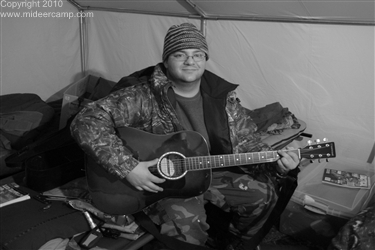Michigan Deer Hunting History
Michigan Deer Hunting History | Deer Camp Photos | Photo Submission | Links |
Before European settlement of Michigan the white-tailed deer was located almost exclusively in the southern portions of Michigan. This was due to the fact that the virgin forests that covered much of Michiganís northern region were dense and allowed for little ground level vegetation for white-tailed deer to subsist on. During these times the white-tailed deer would have served as a source of food for such Michigan Native American tribes as the Miami, Potawatomi, Kickapoo, Fox, and Sauk. The Ojibwa (a.k.a Chippewa) and Menominee tribes of the Upper Peninsula area would have been more reliant on Elk and Moose.
As Michigan was settled in earnest during the early and mid 19th century the landscape and deer population changed dramatically. Farmers in fertile southern Michigan began clearing land eliminating food and cover for the white-tail. Unregulated shooting also thinned the deer population. Logging in northern Michigan provided for increased population as food and cover were more available to the white-tail deer.
Michigan began to regulate white-tail deer hunting in 1859 establishing open season from August 1st to December 31st. The season has continued to change and fluctuate since then. Seasons began to be divided between the Upper Peninsula and Lower Peninsula in 1875. The Michigan Legislature established the statewide season of November 15th to November 30th in 1968.
Regulations began in 1881 when it became unlawful to take spotted or red coat deer while it was in the water, use traps or pitfalls, and to ship deer or parts from the state. Shining and use of dogs was outlawed in 1887.
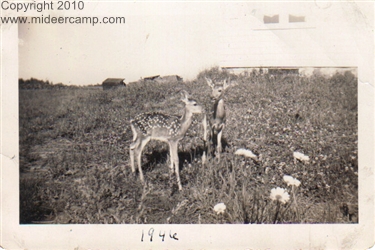
The first deer hunting closure to increase the population occurred in 1891 when hunting in Van Buren and Allegan counties was closed for three years. Periodic closures of varying durations have occurred since then. In fact, statewide deer hunting would not return until 1947.
Deer licenses were first required in 1895 at a cost of $0.50 for residents and $25 for non-residents. 14,477 resident licenses were sold compared to only 22 non-resident licenses. To put this in perspective a loaf of bread cost $0.03 and a new Winchester Model í92 repeater from Montgomery Ward was $10-$12 in 1895. This was also the first year that bag limits were created with a maximum of five. Bag limits were changed to one in 1915 and have changed several times since then. A minimum age of 17 (unless accompanied by a parent) was also set in 1915. The minimum age of 12 was added in 1917. This was changed to age 14 in 1939. A hunterís safety permit, or prior hunting license, for individuals under 17 became required beginning in 1971.
The first archery season and license were established in 1937, but were limited to two counties. Hunters were limited to an archery permit or a firearms permit, but not both. A state-wide archery season was not established until 1944. Hunters were allowed to purchase both archery and a firearms license in 1945, but were still limited to only one deer for both seasons until 1977. The hunter orange requirement was also introduced in 1977.
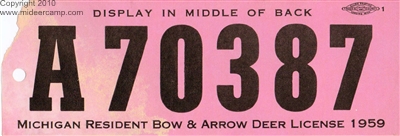
Bear licenses were also included in a deer license beginning in 1928 and continued in at least some counties until 1959 (except in 1939). An additional $2 bear stamp was added in 1959. It was not until 1980 that a deer license could no longer be used to harvest bear in the state of Michigan.
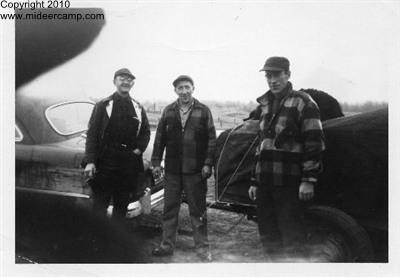
Firearms began to be regulated in 1948 when only shotguns were allowed in southern Michigan. Rifle and shotgun zones were established in 1953.
Regulations and management have continued to change in recent times. Regulations have changed in the last ten years that allow firearms hunting from tree stands and the use of crossbows, both of which were legal until the mid 1900s. Deer management policies change hunting regulations in different areas to permit an adequate deer population and to prevent overcrowding. This has included the attempted control of tuberculosis and chronic wasting disease in the white-tail population, both of which greatly threaten the $500 million Michigan hunting industry.
Deer camps, as we know them today, emerged in the late 1930s and boomed in the post World War II era. This is when economic factors permitted good paying jobs, affordable cars, and paid time off. The creation of the Interstate system in the 1950ís was also a factor. Today we are often over stimulated by technology and the general pace of modern life. Deer camp can offer a brief escape from that world. It is a chance to shed responsibilities and concerns and get back to our roots. While it is nice to have a few modern conveniences at deer camp, all you really need for success is someplace to lay your head, a hot fire, a cool drink, and good friends.
Photo of Ed Brenner Deer Camp 1948
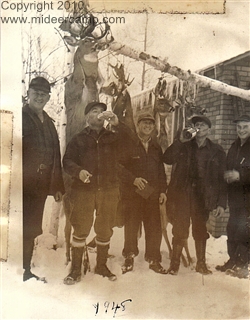
History by "Jimbo" (photo to the Right)
